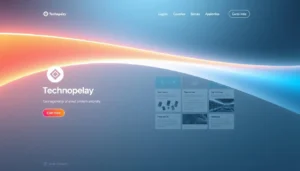Last Updated on: June 19, 2025
Building a student-friendly education website is crucial for engaging students and providing them with a valuable learning experience. An effective educational website can enhance student engagement, improve learning outcomes, and support educational goals.
A well-designed educational website should be both informative and engaging, using a friendly tone that resonates with students. By incorporating essential features and design principles, educators can create a learning environment that is conducive to academic success.
Key Takeaways
- Essential features for a student-friendly education website
- Design principles that enhance student engagement
- Importance of a friendly tone in educational content
- Creating a conducive learning environment online
- Improving learning outcomes through effective website design
Understanding Your Student Audience
Creating an educational website that resonates with students requires a deep understanding of their needs and preferences. This understanding forms the foundation of a user-centered design approach, ensuring that the website is both engaging and effective in supporting the learning process.
Different Age Groups and Their Unique Needs
Students across different age groups have unique needs and preferences when it comes to educational websites. For instance, younger students may require more interactive and visually engaging content, while older students might prefer more in-depth resources and study materials. Understanding these differences is crucial for designing a website that caters to a diverse student population.
Some key considerations include:
- Content complexity and readability
- Navigation simplicity and intuitiveness
- Multimedia integration for engagement
Conducting Effective Student Research
Conducting research to understand student behaviors, preferences, and pain points is vital. This can be achieved through surveys, focus groups, and analysis of user feedback. By gathering insights directly from students, educators can identify areas for improvement and opportunities to enhance the learning experience.
Creating Student Personas for Targeted Design
Creating student personas based on research findings helps guide the design and content creation process. These personas are detailed profiles that outline the characteristics, needs, and goals of different student segments. By designing with these personas in mind, educators can ensure that the website meets the needs of its target audience, thereby enhancing student engagement and improving learning outcomes.
Essential Features for an Educational Website
An effective educational website is built around several key features that enhance the learning experience. These features are crucial in creating an engaging and supportive environment for students.
Learning Management System Integration
A Learning Management System (LMS) is a vital component of an educational website. It allows educators to manage courses, track student progress, and deliver content efficiently. Popular LMS platforms include Canvas, Blackboard, and Moodle. Integrating an LMS enables seamless educational content creation and distribution.
Interactive Learning Tools and Resources
Interactive tools and resources are essential for engaging students and enhancing their learning experience. These can include multimedia content, quizzes, and gamification elements. By incorporating these tools, educators can create a more immersive and interactive learning environment that caters to different learning styles.
Communication and Collaboration Channels
Effective communication and collaboration are critical in an educational setting. Features such as discussion forums, live chats, and video conferencing tools facilitate interaction between students and educators. These channels enable real-time feedback, support, and collaboration, fostering a sense of community and enhancing the learning process.
Progress Tracking and Assessment Features
Progress tracking and assessment features are vital for monitoring student performance and understanding. These features allow educators to identify areas where students need additional support, adjust instruction accordingly, and provide timely feedback. By leveraging these tools, educators can optimize the learning experience and improve student outcomes.
By incorporating these essential features, educational websites can provide a comprehensive and supportive learning environment that meets the diverse needs of students.
How to Create a Student-Friendly Education Website?
Creating a student-friendly education website involves more than just aesthetics; it’s about crafting an online environment that supports learning. A well-designed website can significantly enhance the educational experience, making it easier for students to access resources, engage with course materials, and interact with educators and peers.
Planning Your Site Architecture
Effective planning of your site’s architecture is crucial for a seamless user experience. This involves organizing educational content in a logical and accessible manner.
Information Hierarchy for Educational Content
A well-structured information hierarchy ensures that students can easily find the resources they need. This can be achieved by categorizing content into clear sections and using intuitive navigation menus.
User Flow Optimization for Students
Optimizing user flow is essential to facilitate easy navigation through the website. This can be done by streamlining the navigation process, reducing the number of clicks to access key information, and ensuring that the most important features are readily accessible.
Selecting the Right Development Platform
The choice of development platform can significantly impact the functionality and flexibility of your educational website. You need to decide between using a Content Management System (CMS) and custom development.
CMS Options for Educational Sites
A CMS offers a range of benefits, including ease of use, flexibility, and scalability. Popular CMS options like WordPress and Drupal are widely used in educational settings due to their extensive plugin ecosystems and user-friendly interfaces.
Custom Development vs. Ready Solutions
While custom development offers tailored solutions, it can be more resource-intensive. Ready-made CMS solutions, on the other hand, provide a balance between functionality and ease of implementation, making them a viable option for many educational institutions.
By focusing on a well-planned site architecture and selecting the appropriate development platform, educational institutions can create a student-friendly website that enhances the learning experience and supports academic success.
Designing for Student Engagement and Retention
Creating an engaging educational website is crucial for student retention and academic success. To achieve this, several design elements must be considered to create an environment that fosters learning and interaction.
Color Psychology in Educational Environments
The strategic use of colors can significantly impact the learning environment. Different colors can evoke various emotions and reactions; for instance, blue is often associated with feelings of calmness and trust, while orange can stimulate creativity and enthusiasm. By selecting a palette that aligns with the educational goals, websites can create a conducive atmosphere for students.
Typography and Readability Best Practices
Typography plays a crucial role in the readability of educational content. Choosing fonts that are clear and legible is essential. Best practices include using sans-serif fonts for digital content, maintaining a sufficient font size, and ensuring adequate line spacing to enhance readability.
Visual Elements That Enhance Learning
Visual elements such as images, videos, and infographics can significantly enhance the learning experience. These elements can break down complex information into more digestible formats, making it easier for students to understand and retain information. Effective use of visual elements can also keep students engaged and interested in the content.
Gamification Elements to Boost Engagement
Gamification elements, such as badges, leaderboards, and interactive quizzes, can boost student engagement by making the learning experience more interactive and fun. By incorporating game design elements into educational content, websites can encourage students to participate more actively in their learning process.
Key gamification elements include:
- Badges and rewards for achievements
- Leaderboards to foster competition
- Interactive quizzes and challenges
Creating Compelling Educational Content
The quality of educational content directly impacts student engagement and academic outcomes. To foster a productive learning environment, educators must focus on creating content that is both informative and engaging.
Multimedia Integration Strategies
Integrating multimedia elements into educational content can significantly enhance the learning experience. By incorporating various media forms, educators can cater to different learning styles and keep students engaged.
Video and Interactive Content
Videos and interactive content are powerful tools for capturing students’ attention. Interactive simulations, for instance, allow students to experiment with concepts in a controlled environment, promoting hands-on learning.
Infographics and Visual Learning Aids
Infographics and other visual aids can simplify complex information, making it more accessible to students. Visual learning aids like diagrams and flowcharts help in organizing information and enhancing comprehension.
Content Structuring for Different Learning Styles
Students have diverse learning needs, and structuring content to accommodate these differences is crucial. By incorporating various teaching methods, educators can ensure that all students have the opportunity to learn effectively.
- Using a mix of visual, auditory, and kinesthetic learning approaches.
- Providing content in different formats, such as text, images, and videos.
- Encouraging interactive learning through discussions and group activities.
Maintaining Content Freshness and Relevance
Regularly updating educational content is essential to keep it relevant and engaging. This involves staying abreast of the latest developments in the subject area and incorporating new information into the curriculum.
Some strategies for maintaining content freshness include:
- Reviewing and revising content periodically.
- Incorporating current events and real-world examples.
- Using feedback from students to identify areas for improvement.
Optimizing User Experience for Student Success
The user experience plays a vital role in determining the effectiveness of an educational website for students. A well-designed website can enhance student engagement, improve learning outcomes, and increase overall satisfaction. To achieve this, educational websites must focus on creating an intuitive and personalized experience for their users.
Intuitive Navigation and Search Functionality
Intuitive navigation and robust search functionality are critical components of a user-friendly educational website. By implementing clear categorization and simple navigation menus, students can quickly find the resources they need. A robust search function further enhances this by allowing students to search for specific topics or resources.
Key features of intuitive navigation include:
- Clear and consistent menu options
- Simple and concise labeling
- Prominent search bar
Reducing Cognitive Load and Distractions
Reducing cognitive load and minimizing distractions is essential for maintaining student focus. Educational websites can achieve this by using a clean design, limiting clutter, and ensuring that the most important information is prominently displayed.
As “The more you simplify the user interface, the more you reduce cognitive load.” This principle is crucial in educational settings where clarity can directly impact learning effectiveness.
Personalization Options for Individual Learning Paths
Offering personalization options allows students to tailor their learning paths according to their individual needs and preferences. This can be achieved through adaptive learning technologies, customizable dashboards, and tailored content recommendations.
By incorporating these features, educational websites can significantly enhance the user experience, leading to improved student outcomes.
Mobile Responsiveness for On-the-Go Learning
As mobile devices become increasingly prevalent in education, having a mobile-responsive website is no longer a luxury, but a necessity. With more students accessing educational content on their smartphones and tablets, it’s crucial that educational websites are optimized for various screen sizes and devices.
Adaptive vs. Responsive Design Approaches
When it comes to mobile responsiveness, there are two primary design approaches: adaptive and responsive. Adaptive design involves creating separate layouts for different devices, while responsive design uses a single layout that adjusts according to screen size. The choice between these approaches depends on the specific needs of the educational website.
Mobile-First Design Principles
Adopting mobile-first design principles ensures that the website is optimized for smaller screens from the outset. This approach involves designing for mobile devices before scaling up to larger screens. Key principles include simplifying navigation, using flexible grids, and optimizing images.
Testing Across Multiple Devices and Platforms
To ensure a smooth user experience, it’s essential to test the educational website across multiple devices and platforms. This includes testing on different smartphones, tablets, and desktop computers, as well as various operating systems and browsers. A comprehensive testing strategy helps identify and fix compatibility issues, ensuring that the website is accessible to all students.
- Test on multiple devices and screen sizes
- Check for compatibility with different operating systems and browsers
- Ensure that all interactive elements are functional
Accessibility and Inclusive Design for All Learners
Accessibility in education is not just a legal requirement, but a moral imperative to ensure equal opportunities for all learners. An educational website that is accessible to everyone fosters a more inclusive learning environment, allowing students of all abilities to engage fully with the content.
WCAG Compliance Guidelines for Education Sites
To ensure accessibility, educational websites must comply with the Web Content Accessibility Guidelines (WCAG). Key guidelines include providing alternative text for images, ensuring that all interactive elements can be accessed using a keyboard, and using clear, consistent navigation. WCAG compliance is crucial for making educational content accessible to students with disabilities.
- Provide alternative text for all images and multimedia content.
- Ensure that all interactive elements are keyboard accessible.
- Use clear and consistent navigation throughout the website.
Assistive Technology Compatibility
Ensuring that an educational website is compatible with assistive technologies such as screen readers and speech recognition software is vital. This compatibility allows students with disabilities to access the content using the tools they rely on. Testing the website with various assistive technologies can help identify and fix compatibility issues.
“The power of the Web is in its universality. Access by everyone regardless of disability is an essential aspect.” – Tim Berners-Lee
Creating Inclusive Content for Diverse Learners
Creating inclusive content involves considering the diverse needs of learners. This includes providing content in multiple formats (e.g., text, audio, video), using clear and simple language, and ensuring that all content is culturally sensitive and relevant. By doing so, educational websites can cater to a broader range of learners, enhancing their overall learning experience.
Security, Privacy, and Technical Considerations
Ensuring the security, privacy, and technical reliability of an educational website is crucial for its success and user trust. A well-designed educational platform must balance functionality with robust security measures to protect sensitive user information and maintain high performance.
Data Protection for Student Information
Protecting student data is paramount for educational websites. This involves implementing robust encryption methods, such as SSL/TLS, and complying with regulations like FERPA and COPPA. Regular security audits and updates are necessary to safeguard against emerging threats.
Some key data protection measures include:
- Implementing strong password policies and multi-factor authentication
- Conducting regular security audits and penetration testing
- Ensuring compliance with relevant data protection regulations
Performance Optimization for Educational Resources
Optimizing the performance of educational resources is vital for a seamless user experience. This can be achieved through efficient content delivery networks (CDNs), optimizing images and multimedia content, and leveraging browser caching.
A well-optimized website ensures that educational resources are delivered quickly and efficiently, enhancing the overall learning experience.
Scalability Planning for Growing Student Numbers
Planning for scalability is essential to accommodate growing student numbers and ensure the website remains functional and responsive. This involves selecting scalable infrastructure and designing the website architecture to handle increased traffic and user demands.
Conclusion
Creating a student-friendly education website is crucial for enhancing the learning experience. By understanding your student audience, designing for engagement, and ensuring accessibility and security, you can develop an educational website design that supports student success.
The key to a successful educational website design lies in its ability to adapt to the diverse needs of students. By incorporating interactive learning tools, intuitive navigation, and personalized options, you can create a learning environment that is both engaging and effective.
As you move forward with building your student-friendly education website, remember to prioritize content freshness, mobile responsiveness, and security. By doing so, you can ensure a seamless and productive learning experience for your students.
FAQ
What are the essential features for an educational website?
Essential features include Learning Management System (LMS) integration, interactive learning tools and resources, communication and collaboration channels, and progress tracking and assessment features.
How do I create a student-friendly education website?
To create a student-friendly education website, plan your site architecture, select the right development platform, and design for student engagement and retention.
What is the importance of understanding my student audience?
Understanding your student audience is vital for designing an effective educational website, as different age groups have unique needs and preferences.
How can I optimize user experience for student success?
Optimizing user experience involves intuitive navigation and search functionality, reducing cognitive load and distractions, and offering personalization options for individual learning paths.
What is the significance of mobile responsiveness for educational websites?
Mobile responsiveness is crucial for on-the-go learning, and involves choosing between adaptive and responsive design approaches, adopting mobile-first design principles, and testing across multiple devices and platforms.
How can I ensure accessibility and inclusive design for all learners?
Ensuring accessibility involves following WCAG compliance guidelines, ensuring assistive technology compatibility, and creating inclusive content for diverse learners.
What technical considerations are important for educational websites?
Technical considerations include data protection for student information, performance optimization for educational resources, and scalability planning for growing student numbers.
How can I create compelling educational content?
Creating compelling educational content involves multimedia integration strategies, content structuring for different learning styles, and maintaining content freshness and relevance.
What is the role of gamification in educational websites?
Gamification elements can boost engagement by making the learning experience more interactive and fun.
How can I design for student engagement and retention?
Designing for student engagement and retention involves using color psychology, typography and readability best practices, visual elements that enhance learning, and gamification elements.




